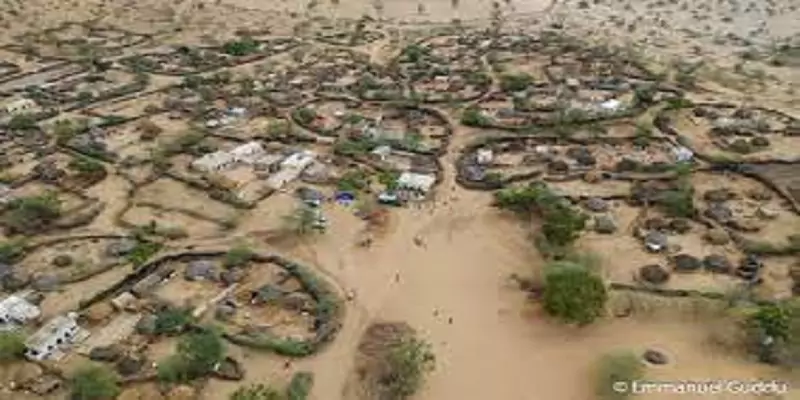Tharparkar
Tharparkar, often referred to as Thar, is a vast and arid region situated in the southeastern part of Pakistan. It is the country's only desert area and covers approximately 19,638 square kilometers, primarily falling within the Sindh province. This region holds great cultural, ecological, and historical significance, embodying a unique way of life shaped by the harsh desert environment.
Tharparkar is characterized by its sandy expanses, undulating sand dunes, and a scarcity of vegetation. The landscape is dotted with sparse thorny shrubs, while occasional salt flats and rocky outcrops break the monotony of the desert terrain. Despite its arid nature, Tharparkar has a distinctive beauty, especially during the rare occurrences of rainfall when the desert blooms with vibrant wildflowers.
The climate of Tharparkar is extreme, with scorching temperatures during the summer months and chilly nights in the winter. Summers can see temperatures soar above 45 degrees Celsius (113 degrees Fahrenheit), making it one of the hottest regions in South Asia. The desert experiences minimal rainfall, and water scarcity is a constant challenge for the residents.
Tharparkar is home to a diverse mix of ethnicities, including the indigenous Thari people, who have adapted to the challenging conditions of the desert. The Thari people have a rich cultural heritage, with their own language, Thari, and a unique way of life that revolves around traditional customs, music, and dance. The region's cultural tapestry is also woven with influences from neighboring regions, adding layers of diversity to Tharparkar's identity.
The communities in Tharparkar are known for their hospitality and resilience in the face of adversity. Despite the harsh living conditions, the people have developed sustainable practices to make the most of the limited resources available, creating a symbiotic relationship with the environment.
Agriculture and animal husbandry form the backbone of Tharparkar's economy. The residents practice subsistence farming, growing crops such as millet, wheat, and pulses in the limited arable land. Livestock, including camels, goats, and sheep, are integral to the economy, providing essential resources like milk, meat, and wool. The traditional knowledge passed down through generations equips the Thari people with the skills needed to navigate the challenges of desert life.
Due to the unpredictable nature of rainfall, water scarcity is a perpetual concern in Tharparkar. Residents rely on wells, ponds, and water conservation techniques to sustain their agricultural activities. Efforts to harness alternative energy sources, such as solar power, have gained momentum in recent years to address the region's energy needs.
Tharparkar faces numerous challenges, with water scarcity being one of the most pressing issues. The dependence on rain-fed agriculture makes the communities vulnerable to droughts, leading to food and water shortages. The government and various non-governmental organizations have initiated projects to address these challenges, including the construction of water reservoirs, the promotion of sustainable farming practices, and the provision of healthcare and educational facilities.
Despite these challenges, the people of Tharparkar exhibit remarkable resilience. Community-based initiatives and local innovations have emerged as responses to the adversities posed by the harsh environment. NGOs and government agencies collaborate with the communities to implement sustainable development projects, aiming to improve living standards and create a more robust infrastructure.
Tharparkar is not just a desert of sand and heat; it also harbors a unique ecosystem adapted to extreme conditions. The desert is home to a variety of flora and fauna, including species specially adapted to survive in arid environments. Indigenous plant species like akk and kandi play a crucial role in preventing soil erosion and maintaining ecological balance.
Efforts to conserve Tharparkar's biodiversity are essential for the overall health of the region. Conservation initiatives focus on preserving the natural habitat, protecting endangered species, and promoting sustainable land-use practices to maintain the delicate balance between human activities and the environment.
Tharparkar boasts a rich cultural heritage, reflected in its traditional architecture, art, and folklore. The region is dotted with historical sites, including ancient temples, havelis, and archaeological remnants that tell the story of Tharparkar's past. The Nagarparkar region, in particular, is known for its historical significance and architectural marvels.
Tourism, though not as developed as in other parts of Pakistan, has the potential to contribute to Tharparkar's economy. Visitors are drawn to the unique desert landscapes, cultural festivals, and the opportunity to experience the traditional way of life. Responsible tourism practices are crucial to ensuring the preservation of Tharparkar's cultural and natural heritage.
Tharparkar, with its challenging desert environment, vibrant culture, and resilient communities, stands as a testament to the human spirit's ability to adapt and thrive in adverse conditions. While facing persistent challenges, the people of Tharparkar continue to innovate, preserve their cultural heritage, and work towards sustainable development. As efforts to address water scarcity, improve healthcare, and promote education gain momentum, Tharparkar has the potential to emerge as a model for sustainable living in arid regions, showcasing the harmonious coexistence of humans and nature.

